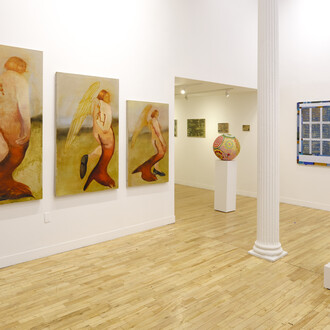Spanierman Modern is pleased to announce the group exhibition, Force of nature, featuring work by Carolyn Marks Blackwood, Stanley Boxer, Nathan Brujis, Marco Casentini, Dan Christensen, Janet Filomeno, Raphaёlle Goethals, Teo Gonzalez, Susan Grossman, Inness Hancock, Felrath Hines, Catherine Howe, Carol Hunt, Mark Kornbluth, Andy Moses, Erin Parish, and Diane Walker-Gladney.
The force of nature is normally thought of as a catastrophic, destructive occurrence beyond the control of mankind. This exhibition hopes to illuminate just the opposite. Much of the art we know and love is inspired by nature. However, the depiction of the landscape was not a recognized art form in the Western canon until the Renaissance and its growing interest in the material world.
It was not until the seventeenth century that artists such as Poussin and Lorrain sought to elevate the reputation of the movement through classical, idealized paintings that represented Arcadia from Ancient Greek mythology. To show the importance of the landscape in art, artists included the attachment of metaphorical meaning to natural elements, the representation of mythical and religious stories set in nature, and the overarching theme of the heroic power of nature over mankind. By the nineteenth century, Romantic artists imbued their compositions with passion and drama to create a more realistic representation of the world that surrounded them instead of the idyllic, balanced paintings of the previous centuries. Painting en plein air came into style in the mid-nineteenth century due to the invention of portable canvases and easels so artists could situate themselves outside. This led to a more expressionistic and subjective depiction of their surroundings as they favored capturing the essence of their world and how they found spiritual meaning in the wonders of nature.
Cezanne’s revolutionary paintings and his introduction of geometric forms as an avenue to create volume paved the way for modern artists to depart dramatically from previous standards of landscape painting. Renaissance artists employed techniques to overcome the obstacle of the two-dimensional plane to create the illusion of a three-dimensional space with depth into a recessed background. Abstract painting rejects this idea and instead emphasizes that the artwork is on a two-dimensional surface: it is an object that occupies space in the material world. Despite the desertion of traditional techniques, abstracted landscapes can be considered a more truthful representation of the natural world because they attempt to capture the literal essence of the physical space instead of presenting an idealized, harmoniously balanced fabrication.
Pollock’s controversial, groundbreaking, and colossal drip paintings can also be considered in this larger discussion of landscape painting, even if works such as Enchanted Forest, Autumn Rhythm, and Lavender Mist can only be identified as such from their titles. In his early education and career, as a student of Thomas Hart Benton, Pollock painted a handful of representational paintings before his technique evolved into what is now known as Abstract Expressionism. This new movement was diametrically opposed to everything art had previously been. The lasting influence of Pollock and the Abstract Expressionist movement can be seen in many of the works included in this show. The style completely rejected definition and representation. Instead, artists desired to shift their focus to the expression of strong emotions through broad, sweeping, gestural brush strokes across vast canvases. The completed works become a record of the physical process that created them. The lack of any hierarchy of elements, subject matter, or a central focal point on which one can focus generates a sense of flux, reminiscent of the everchanging, impermanence of nature.
Today’s artists have the unique privilege of choosing the subject of their works as they are not dependent upon commissions from royal courts or religious organizations. Therefore, the choice to participate in landscape painting implies a level of importance and connection to the subject. The contemplation of nature has always been a convention through which to consider the individual and the broader theme of human interaction with the world. Nature is a force that has always existed and will continue to exist with or without the presence of Man. Although Man is consistently preoccupied with the consideration of nature, he is insignificant to that great force. Through the exploration of one’s world, one can uncover new truths about themselves.
Force of nature features works encompassing all facets of modern representations of landscapes, from photography that presents the world as fact, to abstracted works that significantly depart from their source material. The artists in this show take an individual approach to their depictions of the world in which they exist. Regardless of whether they create representational or abstracted works, the respective processes each artist follows maintain the original philosophies of the art form: it is essentially a form of meditation and consideration of how we impact upon and interact with the environment.
















